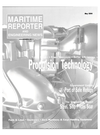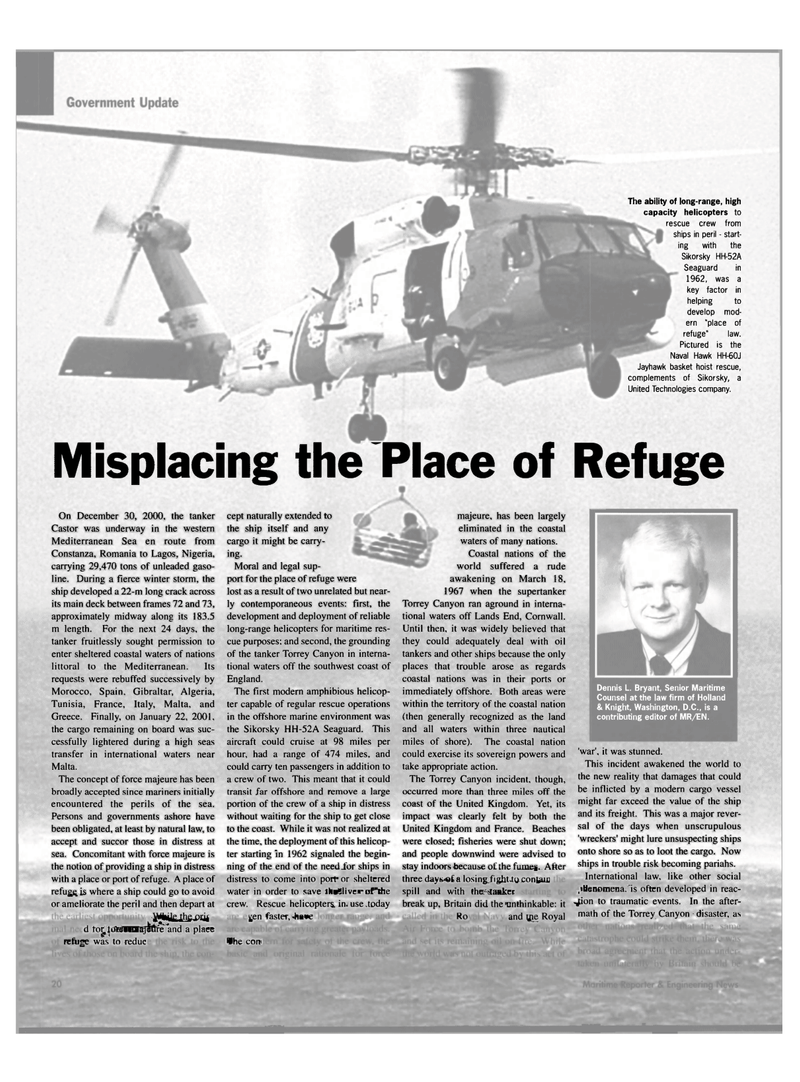
Page 22: of Maritime Reporter Magazine (May 2004)
The Propulsion Technology Yearbook
Read this page in Pdf, Flash or Html5 edition of May 2004 Maritime Reporter Magazine
On December 30, 2000, the tanker
Castor was underway in the western
Mediterranean Sea en route from
Constanza, Romania to Lagos, Nigeria, carrying 29,470 tons of unleaded gaso- line. During a fierce winter storm, the ship developed a 22-m long crack across its main deck between frames 72 and 73, approximately midway along its 183.5 m length. For the next 24 days, the tanker fruitlessly sought permission to enter sheltered coastal waters of nations littoral to the Mediterranean. Its requests were rebuffed successively by
Morocco, Spain, Gibraltar, Algeria,
Tunisia, France, Italy, Malta, and
Greece. Finally, on January 22, 2001, the cargo remaining on board was suc- cessfully lightered during a high seas transfer in international waters near
Malta.
The concept of force majeure has been broadly accepted since mariners initially encountered the perils of the sea.
Persons and governments ashore have been obligated, at least by natural law, to accept and succor those in distress at sea. Concomitant with force majeure is the notion of providing a ship in distress with a place or port of refuge. A place of refugc.is where a ship could go to avoid or ameliorate the peril and then depart at
JdHj^sji d fogorce majeure and a place - was to reduc refuge cept naturally extended to the ship itself and any cargo it might be carry- ing.
Moral and legal sup- port for the place of refuge were lost as a result of two unrelated but near- ly contemporaneous events: first, the development and deployment of reliable long-range helicopters for maritime res- cue purposes: and second, the grounding of the tanker Torrey Canyon in interna- tional waters off the southwest coast of
England.
The first modern amphibious helicop- ter capable of regular rescue operations in the offshore marine environment was the Sikorsky HH-52A Seaguard. This aircraft could cruise at 98 miles per hour, had a range of 474 miles, and could carry ten passengers in addition to a crew of two. This meant that it could transit far offshore and remove a large portion of the crew of a ship in distress without waiting for the ship to get close to the coast. While it was not realized at the time, the deployment of this helicop- ter starting "in 1962 signaled the begin- ning of the end of the need forships in distress to come into port or sheltered water in order to save the lives of the crew. Rescue helicopters in use today ^enfaster, have
The con< majeure, has been largely eliminated in the coastal waters of many nations.
Coastal nations of the world suffered a rude awakening on March 18, 1967 when the supertanker
Torrey Canyon ran aground in interna- tional waters off Lands End, Cornwall.
Until then, it was widely believed that they could adequately deal with oil tankers and other ships because the only places that trouble arose as regards coastal nations was in their ports or immediately offshore. Both areas were within the territory of the coastal nation (then generally recognized as the land and all waters within three nautical miles of shore). The coastal nation could exercise its sovereign powers and take appropriate action.
The Torrey Canyon incident, though, occurred more than three miles off the coast of the United Kingdom. Yet, its impact was clearly felt by both the
United Kingdom and France. Beaches were closed; fisheries were shut down; and people downwind were advised to .stay indoors because otthefumes. After three days of a losing fight to conuuc spill and with the tanker break up, Britain did the unthinkable: it
Dennis L. Bryant, Senior Maritime
Counsel at the law firm of Holland & Knight, Washington, D.C., is a contributing editor of MR/EN. 'war', it was stunned.
This incident awakened the world to the new reality that damages that could be inflicted by a modern cargo vessel might far exceed the value of the ship and its freight. This was a major rever- sal of the days when unscrupulous 'wreckers' might lure unsuspecting ships onto shore so as to loot the cargo. Now ships in trouble risk becoming pariahs.
International law, like other social .lhenomena, is often developed in reac- tion to traumatic events. In the after- math of the Torrey Canyon disaster, as Ro and m Royal
HI
The ability of long-range, high capacity helicopters to rescue crew from ships in peril - start- ing with the
Sikorsky HH-52A
Seaguard in 1962, was a key factor in helping to develop mod- ern "place of refuge" law.
Pictured is the
Naval Hawk HH-60J
Jayhawk basket hoist rescue, complements of Sikorsky, a
United Technologies company.
Misplacing the Place of Refuge

 21
21

 23
23
